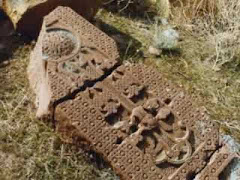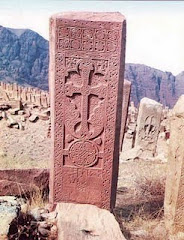June 30, 2006
by Sarah Pickman
A place of memory is wiped off the face of the Earth.
On the banks of the River Araxes, in the remote, windswept region of Nakhichevan, is a small area of land known as Djulfa, named for the ethnic Armenian town that flourished there centuries ago. Today, Nakhichevan is an enclave of Azerbaijan. Surrounding it on three sides is Armenia, and on the fourth, across the Araxes, is Iran.
Hundreds of years ago, almost all of Djulfa's residents were forced to leave when the conquering Shah Abbas relocated them to Isfahan in Persia. But Djulfa was not left completely empty: its cemetery, said to be the largest Armenian graveyard in the world, survived. Inside it were 10,000 or so headstones, most of them the intricately carved stone slabs known as khachkars. Long after the town was emptied, the khachkars, which are unique to Armenian burials, stood like "regiments of troops drawn up in close order," according to nineteenth-century British traveler William Ouseley.
Those stone regiments are gone now; broken down, all of the headstones have either been removed from Djulfa or buried under the soil. No formal archaeological studies were ever carried out at the cemetery--the last traces of a community long gone--and its full historical significance will never be known.
A History of Violence
The oldest burials in the Djulfa (Jugha in Armenian) cemetery date to the sixth century A.D., but most of the famed khachkars are from the fifteenth and sixteenth centuries, when the town was at its most prosperous as a stop on the silk and spice trade routes between Asia and the Mediterranean. After the forced resettlement of 1604, the graveyard endured, and was visited by travelers from within and outside of the Caucasus over the next few centuries. They saw slabs of pink and yellowish stone, between six and eight feet high, intricately carved in relief. Most khachkars, which were believed to aid in the salvation of the soul, were decorated with crosses and representations of Christian holy figures, as well as depictions of plants, scenes of daily life, geometric designs, and epitaphs in Armenian.
By the twentieth century, the carved stones that had survived the forces of time and nature faced a human threat. In 1903 and 1904, part of a railroad line connecting Djulfa to the Armenian city of Yerevan was laid through the cemetery, and a number of khachkars were demolished to make room for the tracks. In 1921, the newly established Soviet government, which had recently gained control over the Caucasus, gave the regions of Nakhichevan and Nagorny-Karabakh, historically part of southern Armenia, to Azerbaijan as part of a divide-and-conquer strategy for controlling the Caucasus. After the new borders were drawn, Nakhichevan was separated from the ruling government of Azerbaijan by Armenian territory. Over the next 70 years, the Azeri population in Nakhichevan grew and almost all of the remaining Armenians emigrated because of political pressure and economic hardship. The Azeris often broke down the stone memorials of Djulfa for use as building material, and by 1998, according to the nonprofit organization Reserch on Armenian Architecture (RAA), there were only 2,000 khachkars left.
RAA, an Armenia-based awareness organization which documents Armenian architectural monuments located outside the borders of the modern republic of Armenia, has studied and published material on the recent history of the Djulfa cemetery. According to RAA, the destruction continued after the fall of the Soviet Union, and local vandals were no longer the only group accused of contributing to the demolition. In 1998, the Armenian government claimed that Nakhichevan's Azeri authorities were deliberately wrecking the cemetery in an act of symbolic violence and had destroyed 800 khackhars. The Armenians appealed to UNESCO and the International Council on Monuments and Sites (ICOMOS), trying to get "the entire international community up in arms," according to deputy culture minister Gagik Gyurdjian. UNESCO responded by ordering an end to all destructive activity in Djulfa. However, the demolition began again in 2002, according to RAA and local witnesses. The last remains of the cemetery were obliterated this past December. Over a period of three days beginning on December 14, 2005, a large group of Azeri soldiers destroyed the remaining grave markers with sledgehammers, loaded the broken stones onto trucks, and dumped them into the waters of the Araxes. That is what witnesses who watched the devastation from across the river in Iran say happened. Among them were representatives from the Armenian Apostolic Church Diocesan Council in the Iranian city of Tabriz, who were able to take photographs, and an Armenian film crew, which captured a significant amount of the event on camera. The video footage from this has been broadcast online through the Armenian community news service, Hairenik.
The Djulfa episode is only the latest in a string of controversies and tragedies that have marred the relationship between the modern nations of Armenia and Azerbaijan. Tensions have run high between the two countries since soon after the fall of the Soviet Union, when, as they asserted their independence, the nations laid competing claims to the Nagorny-Karabakh region, which was under Azeri authority but whose population had remained largely Armenian. The region's local parliament voted to secede and join with Armenia, and fighting erupted between the secessionists and Azeri authorities. The conflict escalated into a full-scale war that involved both armies and unofficial citizen militias from Armenia and Azerbaijan and left thousands dead on both sides. Precariously positioned, Nakhichevan escaped being engulfed in the violence largely because its Armenian population had dwindled to less than 4,000 people and thus was not viewed as a threat by Azeri authorities.
Though a ceasefire was declared in 1994, Armenia and Azerbaijan have not yet reached a permanent agreement regarding Nagorny-Karabakh, and the hostility between the two countries makes the Djulfa destruction even more contentious. There can be little doubt that historical grievances and political land claims have played a part in this attempt to eradicate the historical Armenian presence in Nakhichevan. (to be continued)
http://www.archaeology.org/online/features/djulfa/index.html


No comments:
Post a Comment